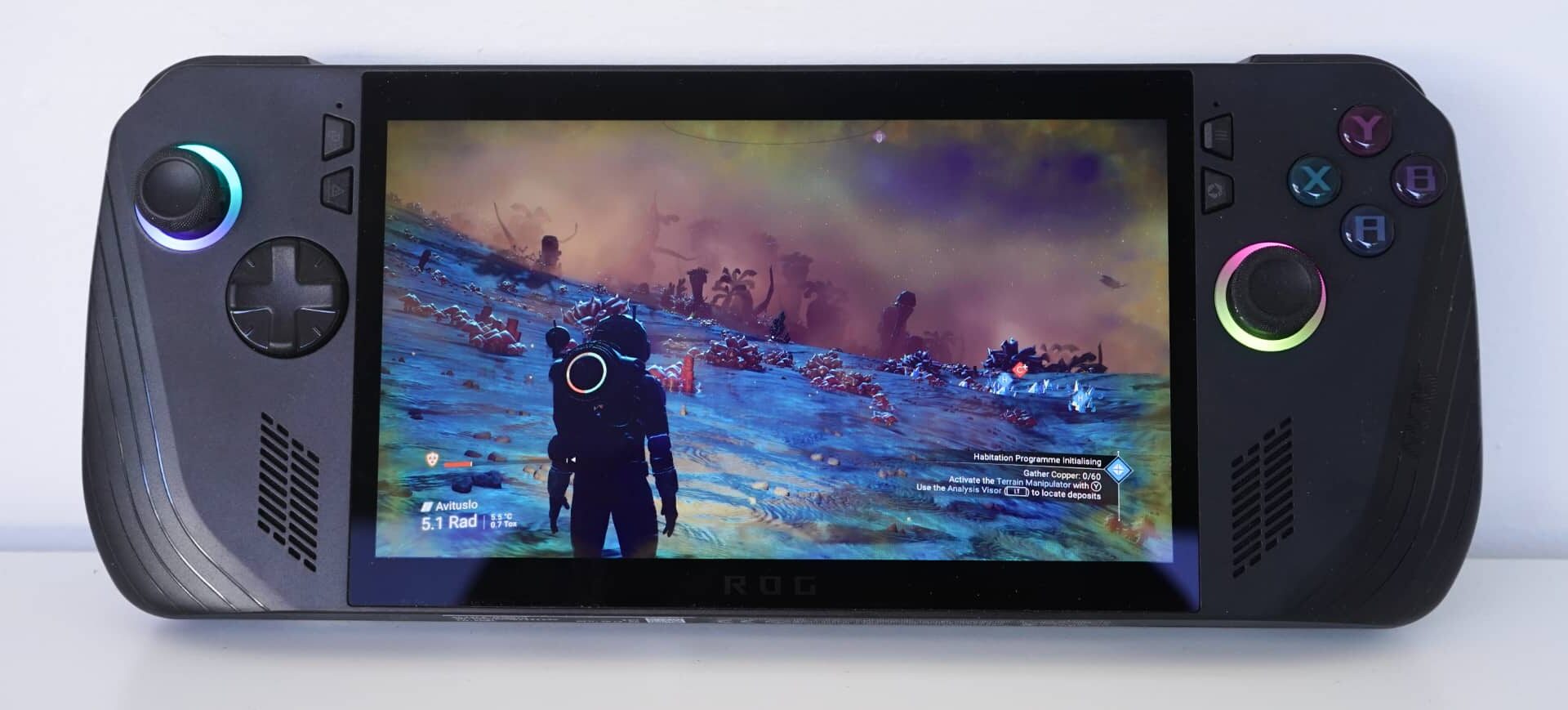Quick review
The good
The not-so-good
One of our favourite computers from 2023 gets a modest update for the new year. Is the ROG Ally X an even better portable gaming machine, or just more of the same?
Ever since the Game Boy first wowed us back in the 90s, portable gaming has been a real and tangible thing. Take a game and a compact system to go, and you’ll have entertainment anywhere you want, but the complexity of those games is changing.
Thanks to the compact computers that are phones and tablets, you can bring a lot of high-quality games to go, and that’s great. There aren’t a heap of dedicated portable gaming systems out there anymore, and now that Microsoft and Sony have largely left portable systems to Nintendo (outside of cloud gaming options), your choices are for portable gaming are typically iPhone, iPad, Android, and Switch.
But there are other options out there, as the PC starts to shift to become truly portable. Not just a compact laptop, but a compact touchscreen PC modelled on much the same approach as a portable gaming system.
That’s where devices like the Asus ROG Ally play, and it definitely left an impression on this reviewer last year. So much that we gave it a best tech award for 2023.
One year on, Asus is giving that model an update and fixing some of the things it definitely needed to fix. Is the Ally X everything the Ally should have been, and is it worth spending on the $1600 portable PC?
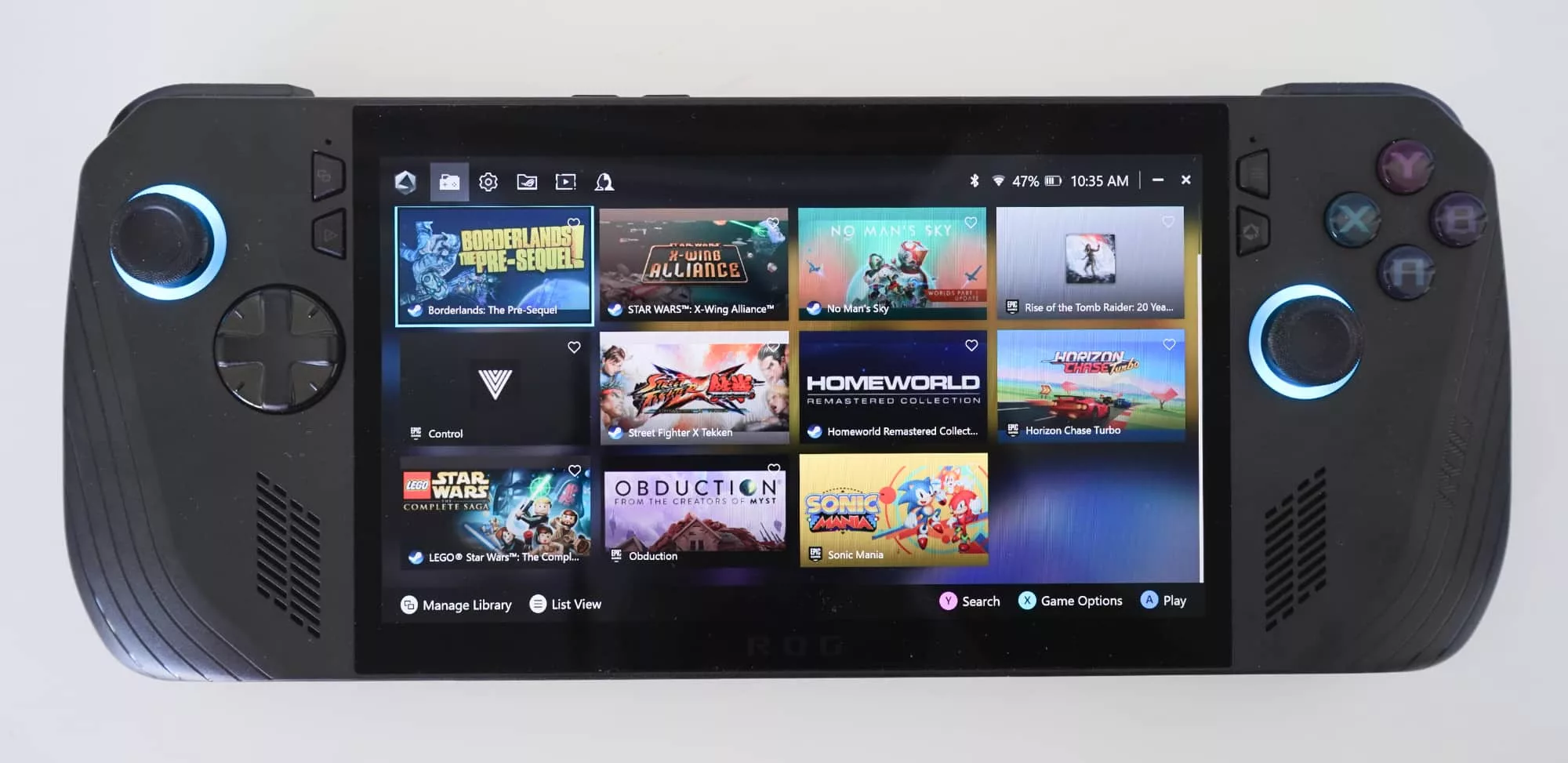
Design
It may well be a new model, but if you’re expecting the X will bring a new design from its X-less sibling, you’re in for a shock: upon first glance, the ROG Ally X is very similar to its ROG Ally sibling. Very similar.
One could even call them the same. They’re not, but they are close.
There aren’t a lot of obvious differences from the top down, though there are changes to the controls: slightly more angles for the shoulder buttons and less plastic for the rear paddles.
The Ally X is different enough without being the same as its sibling, but the idea is still the same: a 7 inch screen flanked by controls on either side, colourful lights, and plastic encasing it all rather nicely. The accents on the back remind us of what we saw in the Zephyrus G14 recently, but somehow made smaller. They’re both part of the Republic of Gamers “ROG” gear, so we’re not surprised.
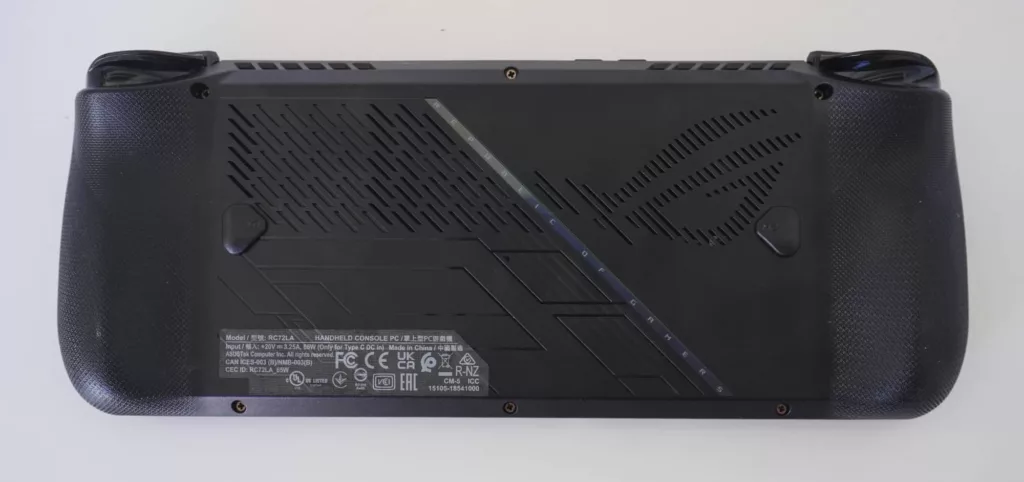
Features
You probably won’t be surprised that the features and specs haven’t changed much, either, if any. It looks similar, but it’s not entirely the same, with a few tweaks here and there that really make the difference, including the removal of one of the useless ports. Say goodbye to the proprietary port from last time and hello to an extra and more useful USB-C port.
On a technical level, you might brush the Ally X as more of the same because, well, it kind of is.
There’s the same AMD Ryzen Z1 Extreme chip with AMD RDNA 3 graphics inside, though the memory has been boosted to 24GB compared to the 16GB before, and the storage is now 1TB compared to 512GB SSD.
WiFi is still covered by 802.11a/b/g/n/ac/ax WiFi 6E, while Bluetooth runs at version 5.2. There are two aforementioned USB-C ports on this model, as well as a microSD slot and a 3.5mm headset jack, handy if you prefer to plug headphones in rather than go wireless. However, there are also two speakers with support for Dolby Atmos virtualised surround.
Outside of the minor technical changes, Asus has upgraded one item seriously: the battery. While the original Ally offered a 40WHr battery, the Ally X doubles the capacity to 80WHr, giving you an idea where a lot of the impact is going to be. It’s not just improvements to memory, but also the battery.
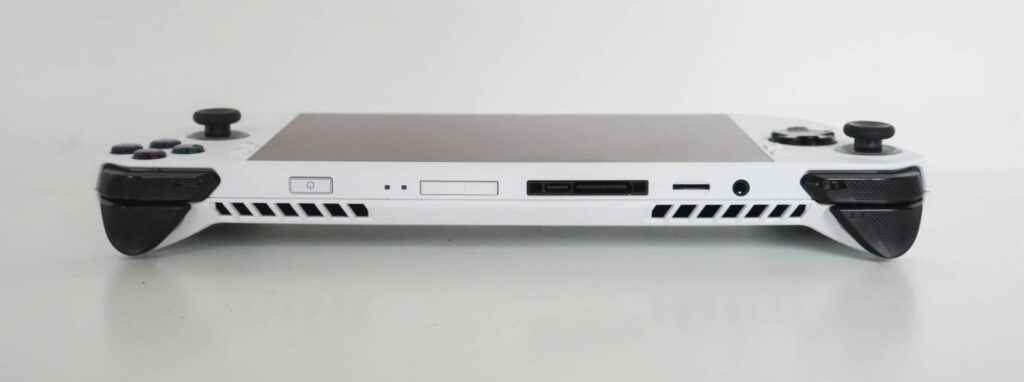

Dealing with the extra size means Asus has changed some of the ports, with the microSD slot now found on the right edge next to the power button, the volume now on the left alongside two USB-C ports on replacing one of the Asus proprietary ports on the original, and what looks like a venting port or speaker on the top edge.
You can also find a fingerprint sensor under the power button on the right edge, in an easy spot for your finger to get to as you grip the system on the right side.
| Model | Asus ROG Ally X (RC72LA) |
| Chip | AMD Ryzen Z1 Extreme |
| RAM/Storage | 24GB RAM; 1TB |
| OS | Windows 11 Home |
| Display | 7 inch 1920×1080 Full HD IPS |
| Connections | WiFi 6E, Bluetooth 5.2, USB-C, microSD, 3.5mm headset |
| Weight | 678g |
| Price | $1599 AUD |
Display
One thing definitely hasn’t changed: the screen.
You’ll find an identical 7 inch Full HD display here supporting touch and Corning’s scratch-resistant Gorilla Glass Victus, displaying a decent amount of colours and crisp imagery, but while offering a maximum refresh rate of 120Hz.
Sure, it’s not quite on the level as the OLED displays popping up in laptops, or even the even faster 240Hz to 480Hz screens gamers looking for super slick animations are craving. But given the size on offer, the 7 inch ROG Ally X display looks great and fits in luggage all too easily, possibly even some ridiculously large jeans pockets.
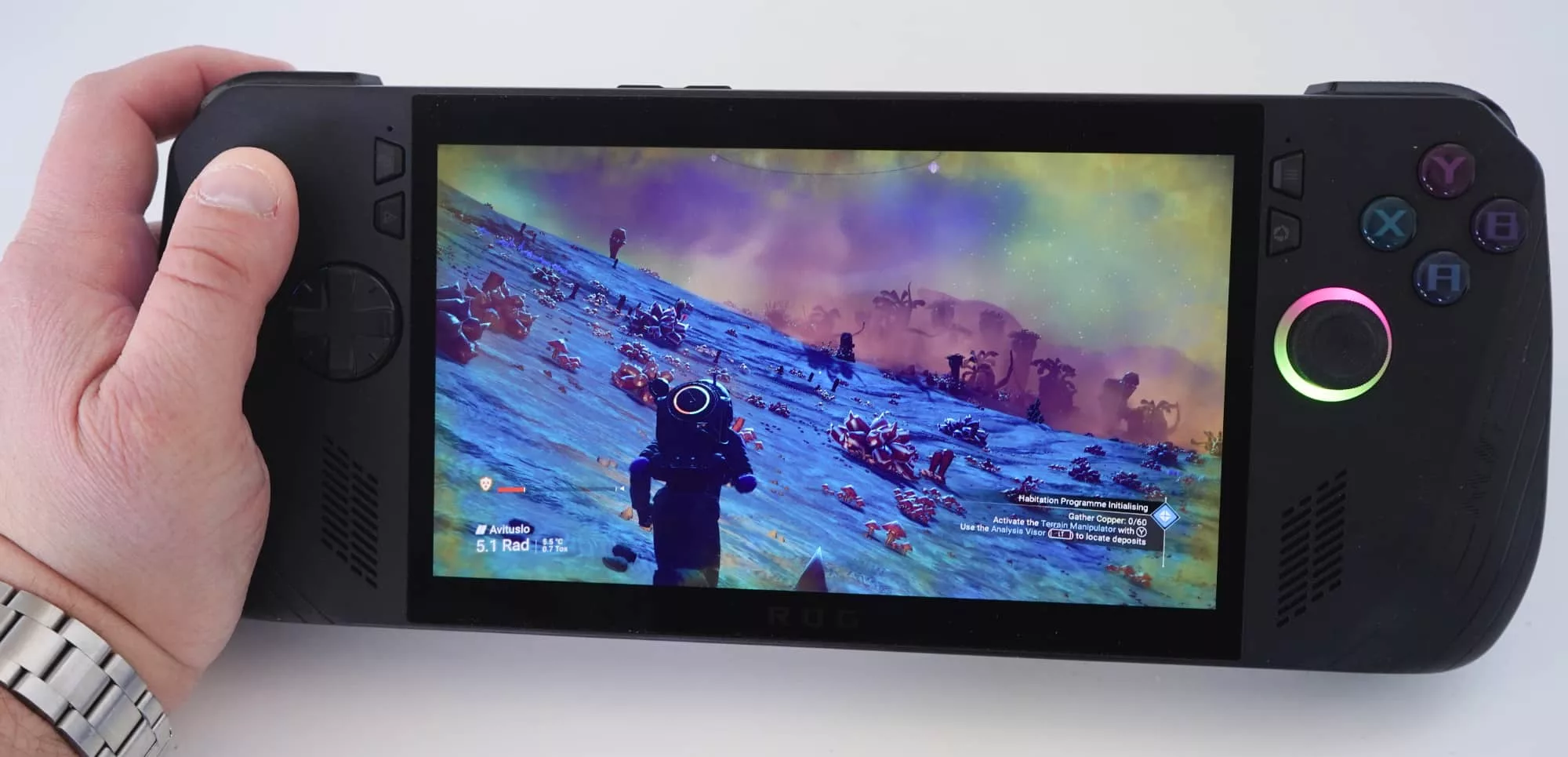
In-use
Start using the ROG Ally X and much like we saw in the first generation, you’ll find pretty quickly that Windows in a portable format isn’t really made for games. Typically, Windows is fine for games, and given how most games are made for Windows (as opposed to Mac), Windows is arguably the best computer platform for games.
But Windows in a pint-sized form-factor without a mouse or keyboard? That’s less great for games. Certainly less than desirable, largely because you don’t have those peripherals, and even if you did, the screen would be too small.
To help with that, Asus has a bit of software it includes called the “Armoury Crate”, which not only acts as a front-end for the Asus light-up controls and other drivers, but also provides an interface to let you browse and play your games. In short, think of it as an overlay to let you see what you have, and to help you easily hit the shortcuts for what you want to play.
Armoury Crate helps in other ways, loading Steam’s Big Picture mode to let you browse with ease, but it won’t always play nicely with every other game launcher.

You’ll still need to touch Windows like you normally will; we set up the ROG Ally X from scratch and needed to install Epic’s Game Launcher, but Steam came preinstalled. It was the same for GOG’s installer, too.
We needed to go through each of the installs as normal, however, and typing in your username and password a login system isn’t super fun on a touchscreen keyboard that tends to take up half the screen you’re trying to see.
The downside of the small screen is that Windows just isn’t made for it. Asus has done fairly well all things considered — you get a Full HD screen in that 7 inch screen — but 1080 pixels high is barely enough for some of the screens in Windows to be useful. As it is, we had to change the viewing size from 150% where it’s comfortable to 100% where everything was super tiny just to get our benchmarking software to run!

But you’ll manage. You’ll have to, really, because the experience of playing your games in a portable environment is really cool when it works.
Games can be fickle at times, and not everything will naturally work with the joystick and directional pad controls mounted to the side of the Ally X, but most titles do, and that’s a win. Once you get past the hurdles and have the games you want installed, it is largely plug and play.
Performance
Interestingly, despite the system being very similar on paper to its predecessor, the performance puts the Ally X slightly above its predecessor, thanks in part to the boost in memory. Asus has effectively doubled the RAM from last time, jumping from 12GB to 24GB, though Windows was quick to note that only 15.7GB was actually usable.
It’s not a staggering increase in performance, but it’s one you can see in benchmarks: graphical prowess is largely the same — it should be given it’s the same Ryzen Z1 Extreme chip — but single core and multi-core capability has a little more in the kitty, and that’s great news.
Compare the Ally X to some other computers and you’ll find the portable can hold its own, too.
It’s as capable as the M2 MacBook Air in our tests, and not far from the M3 edition, neither of which is known for playing heaps of games, but can given the improvements in Mac gaming libraries. The recent Intel-based Acer Swift Go 14 has a slight edge given it’s based on the Intel Core Ultra chips rolling out this year, while another Asus dedicated gaming model, the ROG Zephyrus G14 is much, much faster.
These are all different beasts, though. Not a single one of these competitors is compact enough to fit in small hand luggage, while the Ally X definitely is. We’re technically comparing apples and oranges here, or even apple, oranges, and a strawberry. In this metaphor, the Ally X is the strawberry: it delivers a lot and really packs a punch.
Playing a recent Tomb Raider, the portable delivered solid frame rates and gameplay with next to no lag, while the always taxing No Man’s Sky worked a treat, as well.
You’re only gaming to a maximum of Full HD here, and of course, you can tweak the visuals like you can on any PC, but the AMD-powered Ally X handles its own. It’s delightful.
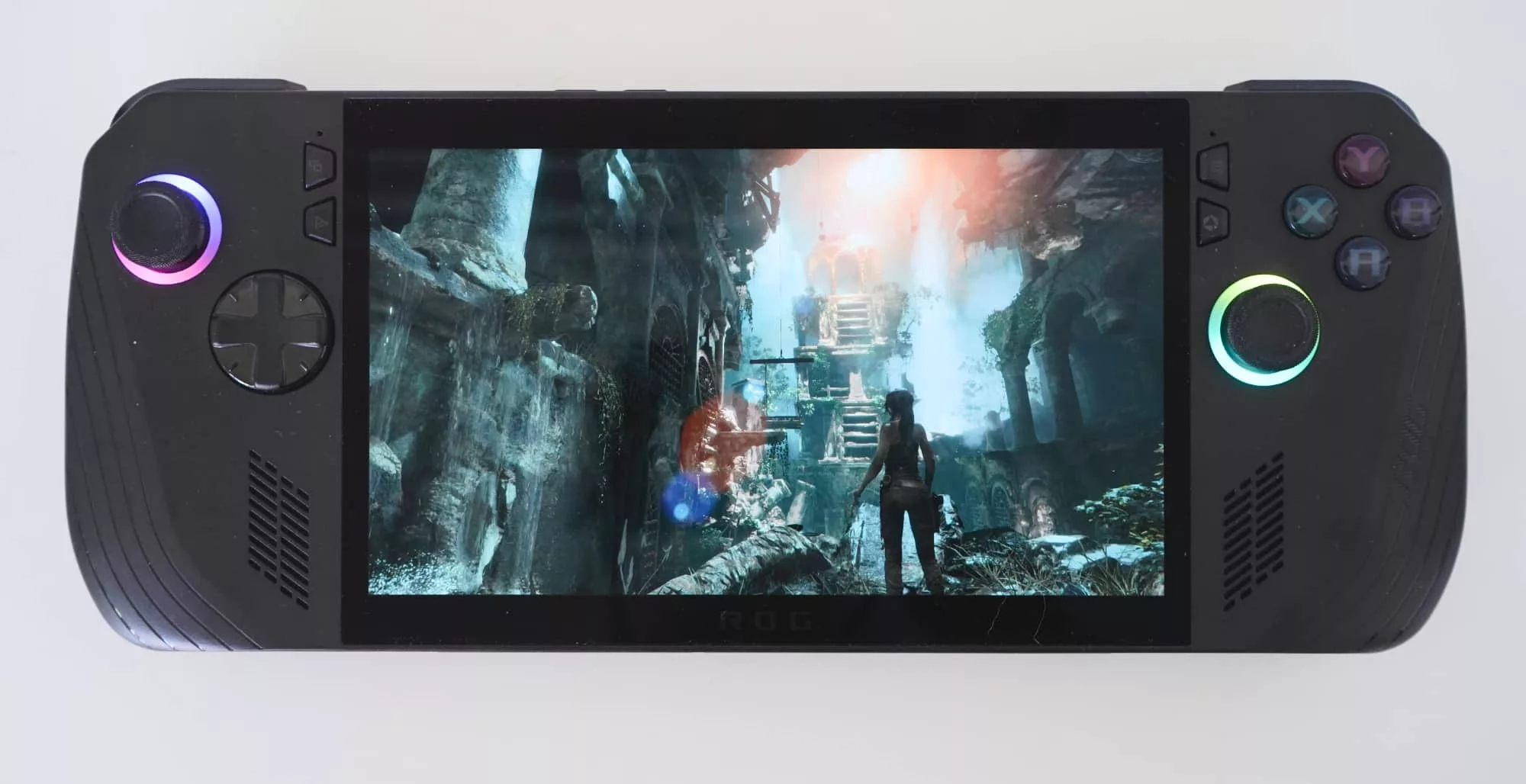
Battery
You’ll also find a little more from the battery, too, hardly surprising given there’s literally double the supply in the machine.
We found a battery life more consistent with actually playing a game, hitting between 2 and 4 hours depending on what you were gaming with and how taxing it was on the system. Play a deliberately less taxing graphical piece and you could see even more battery life.
The point is you can actually play games without being plugged in on this thing, an important point because the battery on the original Ally was small enough you’d need to keep a USB-C power pack nearby, and a chunky one at that.
You still might want to with the Ally X — keeping your portable topped up is always helpful when you’re on the go! — but the fact that you can get more life out of what is basically a compact powerhouse is always a good thing.
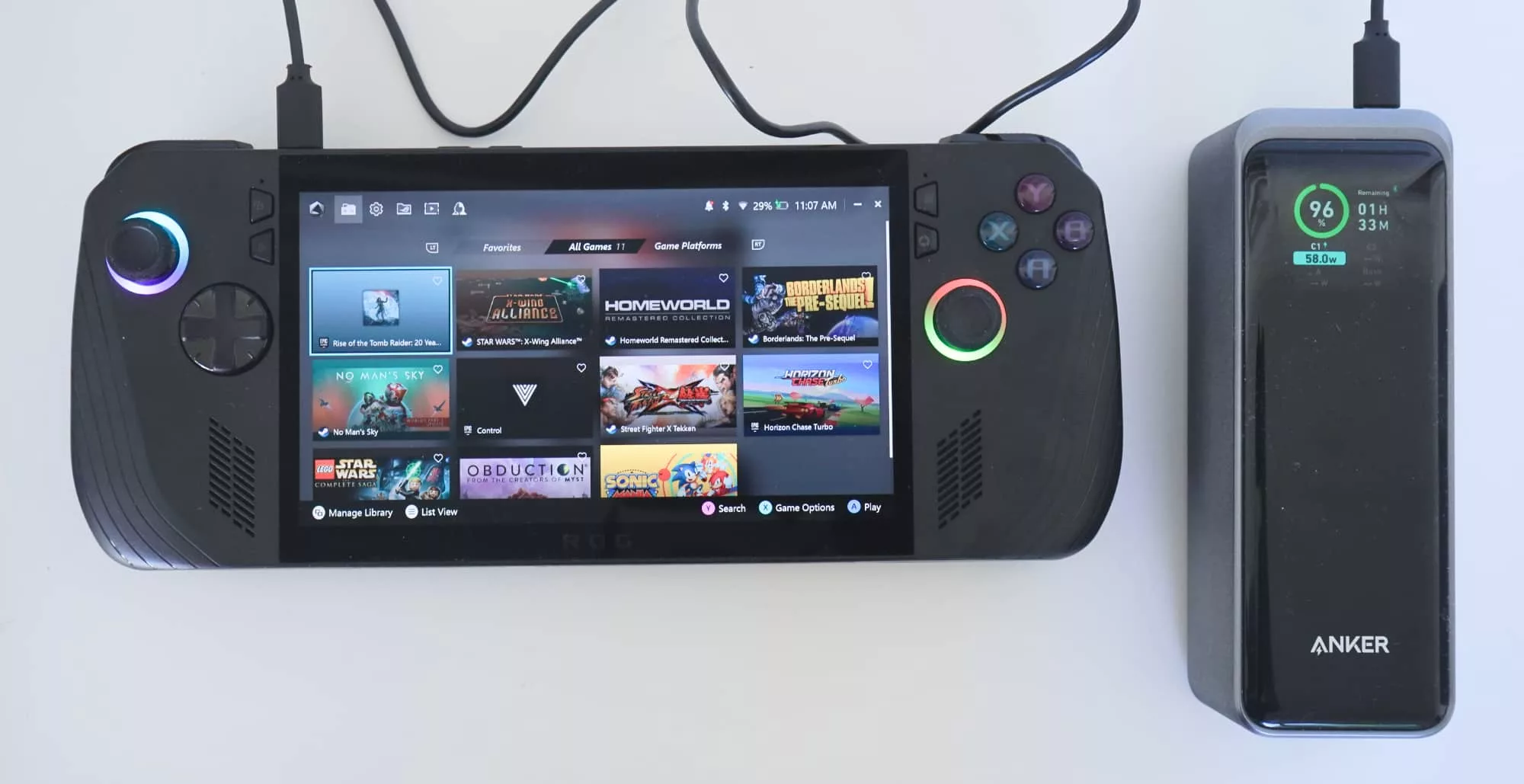
Value
Priced at $1599 in Australia, the Asus ROG Ally X is slightly more expensive than its predecessor, adding $300 more to the cost of the original ROG Ally. Given the changes, you probably shouldn’t be surprised.
And given the changes, we think the value is technically better now than it was before. You’re getting more memory and more battery, both of which aren’t small upgrades in the grand shame of things.
Yes, it’s still technically expensive, but these sorts of computers are still relatively rare in Australia. And giving credit to Asus where it’s due, the combination of technology makes this one of the more useful portable gaming computers out there, especially since Valve’s SteamDeck hasn’t been officially released locally.
What needs work?
So the problem isn’t the performance. That’s fine and great. It’s also not the battery life, which sees improvements. And it’s also not the value, which while the machine costs more, it’s not a staggering increase given the changes Asus has made, each worthwhile in the grand scheme of things. It’s not even the lack of a built-in kick stand, which would have been a stellar improvement, but still isn’t here. There’s a cardboard one in the box as an extra, but we’d love a kickstand.
Rather, the problem is Windows, which doesn’t always offer a great gaming experience on a compact screen. Or in general.
Games crash, and Windows has runtime errors that cause titles to stall and not run. While these sorts of issues are often relatively easy to remedy when you have a keyboard and mouse, they’re a pain in the proverbial when you don’t.
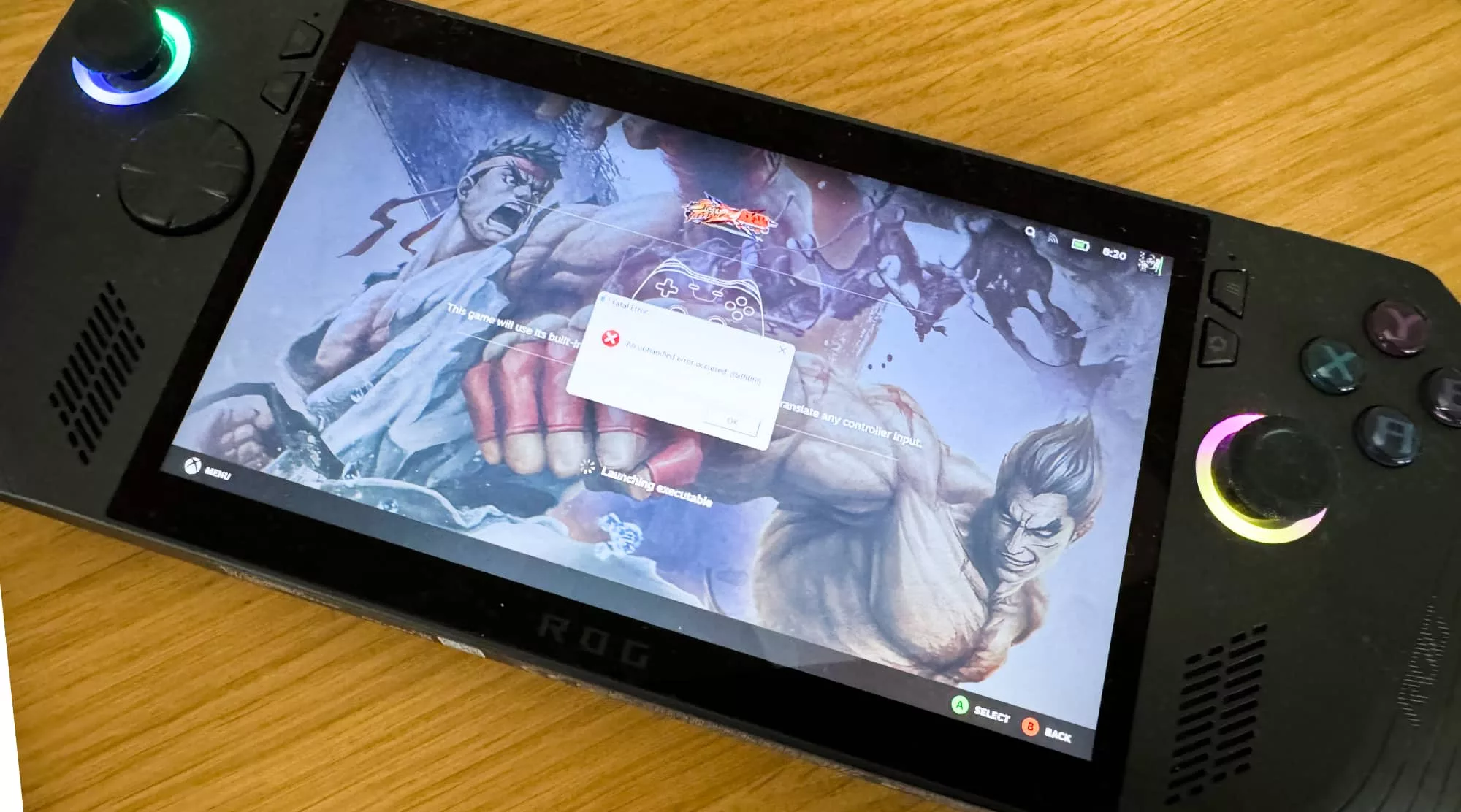
In one instance, Windows reported a major error with Street Fighter x Tekken, which should just have just killed the game instance altogether.
Instead, Windows got stuck, seemingly trying to run the game in a loop that wouldn’t work, forcing us to try to close the game using the taskbar, but just not getting there. Weirdly, a ctrl+alt+del Task Manager force quit would have nailed it, but that’s not exactly available when you have no keyboard.
We wish this was an isolated incident. Some games work beautifully, and some don’t. There’s no way to gauge which ones will work better than others, you just kind of have to roll with the punches and deal with things. Don’t even bother with games that require a mouse and haven’t been updated for controls. It just won’t happen.
Frustratingly this isn’t really an Asus issue; this is all just more Windows frustrations of being a PC gamer. You’re going to find bugs and crashes, and you as a gamer on a Windows PC will have to find workarounds. PC gaming isn’t like console gaming; things don’t always work flawlessly the way they do on consoles.

But while Windows is typically the problem, the keyboard, mouse, and a way to quickly multitask to open a browser and consort with other gamers is the solution, and it’s one the Asus ROG Ally X doesn’t solve.
It’s too small to be a multitasking machine, and the lack of keyboard and mouse means you’ll be dependent on another device you own — the phone — to go digging for an answer.
Or just do what also works: hold down the power button, and turn it off and on again. It works. Frustrating, but it works.
Final thoughts (TLDR)
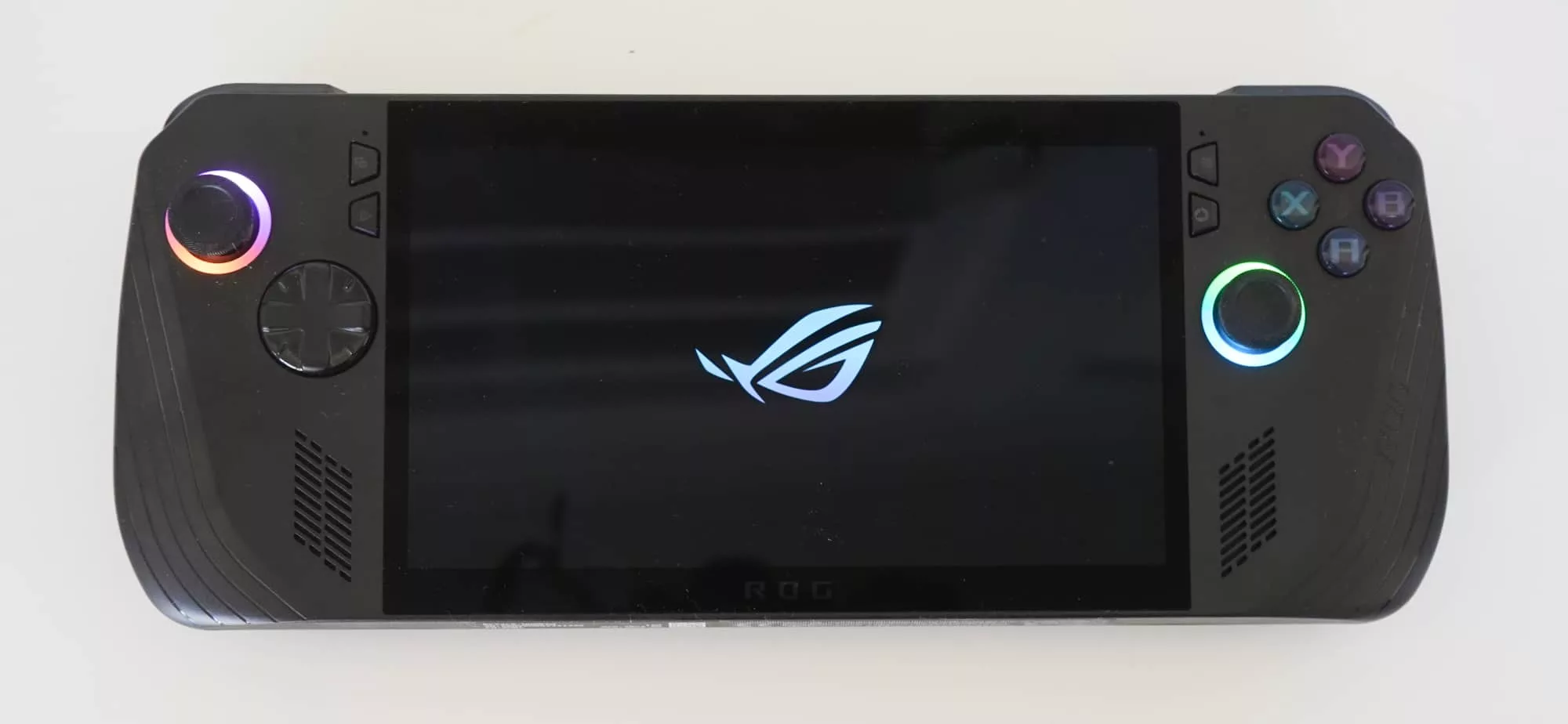
Outside of Windows making life awkward on a smaller screen, there’s a lot to love about the Ally X, especially if you love gaming but struggle to get it done on a computer.
We wish we had the time to game more, but between jobs and parenting, there’s not always time to dig in to the ever-growing library of titles we always find ourselves adding. Steam and Epic sales keep increasing that library, but the time to play hasn’t increased with it.
What this reviewer loves about the ROG Ally X is how it makes gaming possible anywhere. You don’t need to especially carry a large laptop just for a gaming session, and instead can whip out an oversized Game Gear of sorts made for modern day gaming. That’s amazing.
We owned a Sega Game Gear growing up and have fond memories of the thing. In many ways, the Asus ROG Ally X rekindles those in the best way: it’s a similarly-designed device that lets you game wherever, and brings the performance you expect today in a device you can use today and tomorrow. That matters. That counts.
Sure, the price is a little higher than you may expect: it’s a portable powerhouse, after all. You’re in many ways carrying around a Windows-based edition of a portable Xbox. We wouldn’t expect that to come cheap.
But if you yearn to game and feel the urge to do it anywhere, the ROG Ally X will make it happen.



